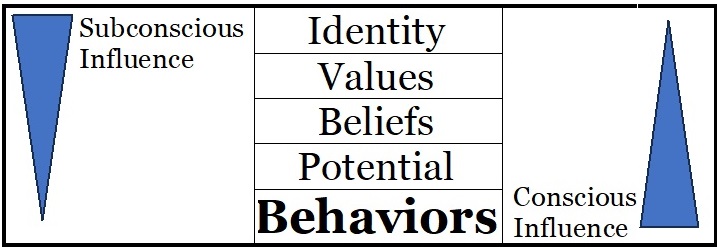Mental Layers: Behaviors

Our behaviors are one of the few exterior representations of our inner mind. Some of our behaviors are constructive, while others can be either passively or actively destructive. We often try to tell ourselves that our conscious mind is sufficient to control our behaviors. While it's true that our behaviors are mostly conscious, it turns out that our behaviors are at the bottom of the mental layers hierarchy. That means that our behaviors are merely the result of our identity, values, beliefs and potential. In other words, our behaviors are like the caboose on the train: being pulled in whatever direction the rest of the train is already going.
That might sound like bad news, and a lot of folks have concluded that they are powerless to change their behaviors. The good news is that when we tap into the subconscious mind, we have access to the other levels of the mind which drive those behaviors. With either hypnosis and/or NLP, we can change the elements which drive those behaviors. Let's dive in a bit deeper.
How Behaviors Reveal Themselves
Behaviors are unique in the mental states, because so many of our behaviors are actually visible to observers. This makes them relatively easy to identify. However, many of our behaviors are actually invisible, because they fall into the category of what we don't do. For instance, the casual observer does not see us doing the following behaviors:
- procrastination
- indecision
- lack of follow-through
- doing Y when we actually intended to do X
You get the idea. Regardless of why, sometimes our behaviors contradict our intentions, no matter how motivated we might be. The good news is that we have numerous ways to change that.
When we start to think about the changes we want to make, it can be educational to listen for how we describe ourselves. The way we describe a thought, feeling or action will usually indicate which layer is involved. For instance, the Behaviors layer is speaking to us when we use the following language patterns:
- I do <verb>, such as "I do my bills as soon as they come in"
- I act (verb<, such as "I act jealous when she's around"
- I <verb>, such as “I eat too much” or "I oversleep a lot"
- I find it easy to <verb>, such as "I find it easy to overspend"
- I find it difficult to <verb>, such as "I find it difficult to concentrate"
- I choose <verb>, such as "I choose to waste time on social media"
- I see myself <verb>, such as "I see myself failing the test"
- I hear myself <verb>, such as "I hear myself apologizing again"
- I find myself <verb>, such as "I find myself at the mall too often"
- I feel myself <verb>, such as "I feel myself losing my temper
The above statements are indicative of behaviors which exist, without actually carrying out the behavior itself. These are particularly helpful when we're trying to categorize behaviors that we want to work on, modify, or eliminate.
How Our Behaviors Shape Our Lives
One definition of behavior is: "the aggregate of responses to internal and external stimuli." This particular definition is helpful because it emphasizes two things:
- Our behaviors are rarely ever a single response to something, but rather a combination of potential responses wrapped into a single action (or inaction).
- Our behaviors are a response to both external and internal stimuli.
These two ideas will be crucial as we continue to explore the Behavior mental state, and discuss options for modifying, eliminating or replacing behaviors.
How Our Behaviors Can Create Problems
Human beings tend to focus on what's not working, rather than giving credit to what is working. So it's important to first acknowledge that most of our behaviors are perfectly functional and beneficial. They help us move through the day, socialize with others, and take care of ourselves. The reason that's important to remember is that sometimes we really get wrapped up in a few behaviors that are causing problems. That can become very discouraging, which sets in motion a lot of angst and stress. So before we talk about problem behaviors, let's first give ourselves credit for what we're doing right. For most people, most of the time, our behaviors are beneficial and appropriate. The goal here is to target just those behaviors which are causing problems, without disturbing the rest.
With that in mind, no pun intended, let's take a look at behaviors that cause problems. There are a lot of individual behaviors that might cause issues, but those issues can be broken down into a few big categories:
- create friction between ourselves and other people
- get in the way of accomplishing our goals or getting the results we want
- prevent us from participating in activities, or compel us to say, think or do things we'd rather not do
- harm us or hold us back in some way
Naturally, many people would like to change disruptive, dysfunctional or undesirable behaviors. You'd think that since the Behaviors layer is within the conscious mind, it would be relatively easy to change undesirable behaviors. Except anyone who has tried to change an undesirable behavior or eliminate a bad habit, can tell you it's difficult. Why? Recall that the Behaviors layer is actually at the bottom of the layers hierarchy. In other words, our Behaviors are driven by our identities, values, beliefs, and even our perceived potential. If that's the case, how in the world do we finally change our behaviors? This is where hypnosis and other NLP techniques really shine.
Change Our Behaviors, Change Our Lives
The vast majority of clients who seek out hypnotherapists and NLP practitioners are in search of ways to change behaviors. These individuals have often tried multiple methods (sometimes for many years) without success. They failed to change those behaviors because they were relying upon conscious mind methods, such as affirmations and storyboards. Sometimes they relied upon sheer willpower. Sadly, those approaches rely upon our various mind layers already being in alignment with each other. But if that were the case, we wouldn't be having issues to begin with. It is precisely because the other layers are NOT in alignment that we are trying to do one thing and end up doing something else. That means we have to work with the subconscious to change those other layers first.
As we've seen on other pages, hypnotherapy and NLP techniques are ideally suited to making these kinds of changes. We can use these techniques to identify the values, identities and beliefs which are causing the problem, then change them or replace them with something more desirable. As we've seen on those other mental layer pages, once we've changed those layers, the changes cascade down through all the other layers. Ultimately, that results in changes to our behaviors. Ironically, the behaviors which are hardest to change via conscious methods, often change automatically when we use subconscious methods. What was once beyond our abilities, now occurs without any effort at all.
The other piece of good news is that we can learn to do this on our own. If you can read and follow directions, you can successfully learn self-hypnosis and NLP techniques. If that's an approach you're interested in pursuing, check out the Transform Destiny website for a very comprehensive list of online courses that will teach you everything you need to know.
If that sounds really intimidating, or you want or need solutions right away, you can of course also work with a certified hypnotherapist, success coach or NLP practitioner. If that's the course you'd like to take, contact me and let's set up a time to discuss your needs.
|
Shopping Cart |
|
Contact Me For Help Reaching Your Goals

When you're ready to move forward, push through obstacles and make real progress towards your goals, Contact Me today.
New Products and Services Request Form
Do you have a product or service request that you don't already see listed here? I'd love to hear your ideas! Please feel free to either Contact Me or fill out my new Product and Service Request Form.
Thanks for your suggestions!
